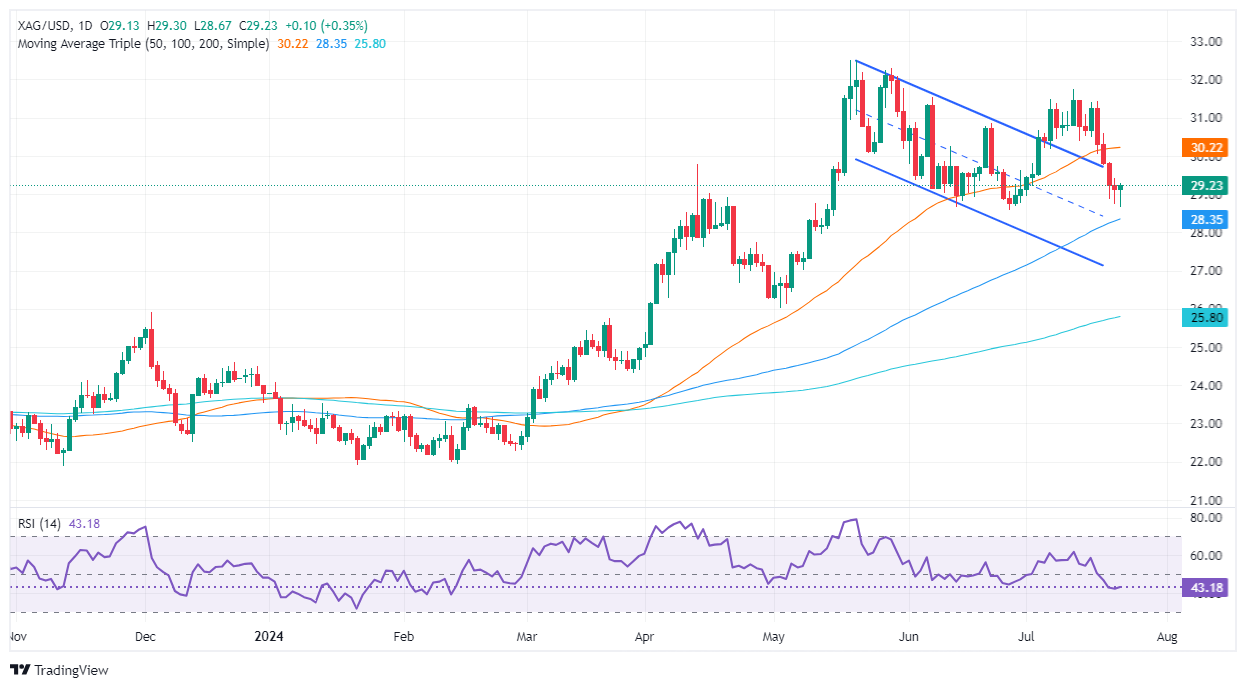Silver Price Analysis: XAG/USD rebounds off four-week lows, surpasses $29.00
- Silver at $29.22, up 0.40%; 'hammers' suggest strength above $29.00.
- Rising RSI indicates increasing buyer momentum; resistances at $29.42, $29.83, $30.00.
- Downside risks: support at $28.67, with further levels at 100-DMA ($28.34) and $28.00.
Silver's price stages a recovery after diving to four-week lows of $28.67. It climbs back above $29.00, registering gains of more than 0.40%, and trades at $29.22.
XAG/USD Price Analysis: Technical outlook
Technically speaking, XAG/USD has formed a back-to-back session of ‘hammers,’ with sellers unable to push Silver’s price below the $29.00 mark, opening the door for further upside.
Momentum shows that neither buyers nor sellers are in charge, but the recent uptick in the Relative Strength Index (RSI) is a sign that buyers are moving in.
If XAG/USD rallies above the July 22 high of $29.42, it could extend towards the July 19 peak at $29.83. A further upside is seen above that level, with the $30.00 mark lying overhead, before challenging the 50-day moving average (DMA) at $30.12. A breach of the latter will expose the July 17 high at $31.42.
Conversely, if XAG/USD drops below $28.67, that could sponsor a test of the 100-DMA at $28.34. Once surpassed, the next demand zone would be the $28.00 figure.
XAG/USD Price Action – Daily Chart

Silver FAQs
Silver is a precious metal highly traded among investors. It has been historically used as a store of value and a medium of exchange. Although less popular than Gold, traders may turn to Silver to diversify their investment portfolio, for its intrinsic value or as a potential hedge during high-inflation periods. Investors can buy physical Silver, in coins or in bars, or trade it through vehicles such as Exchange Traded Funds, which track its price on international markets.
Silver prices can move due to a wide range of factors. Geopolitical instability or fears of a deep recession can make Silver price escalate due to its safe-haven status, although to a lesser extent than Gold's. As a yieldless asset, Silver tends to rise with lower interest rates. Its moves also depend on how the US Dollar (USD) behaves as the asset is priced in dollars (XAG/USD). A strong Dollar tends to keep the price of Silver at bay, whereas a weaker Dollar is likely to propel prices up. Other factors such as investment demand, mining supply – Silver is much more abundant than Gold – and recycling rates can also affect prices.
Silver is widely used in industry, particularly in sectors such as electronics or solar energy, as it has one of the highest electric conductivity of all metals – more than Copper and Gold. A surge in demand can increase prices, while a decline tends to lower them. Dynamics in the US, Chinese and Indian economies can also contribute to price swings: for the US and particularly China, their big industrial sectors use Silver in various processes; in India, consumers’ demand for the precious metal for jewellery also plays a key role in setting prices.
Silver prices tend to follow Gold's moves. When Gold prices rise, Silver typically follows suit, as their status as safe-haven assets is similar. The Gold/Silver ratio, which shows the number of ounces of Silver needed to equal the value of one ounce of Gold, may help to determine the relative valuation between both metals. Some investors may consider a high ratio as an indicator that Silver is undervalued, or Gold is overvalued. On the contrary, a low ratio might suggest that Gold is undervalued relative to Silver.